Lefkara Lace Embroidery by Androula Hadjiyiasemi is perhaps the only thorough book written on Lefkara lace. I’ve hesitated to review the book, because it’s Really Hard to find at an affordable price. So far, I’ve only found one or two copies online, and they’re running about $90. Today, I’ll show you what the book is like, so that, if you are are interested in Lefkara lace, you can decide whether or not it’s worth the investment to buy a used copy of the book or the effort to hunt one down somewhere! The library system can be very handy for this, though I haven’t found the book available in many collections.
While I take you through the book, I’ll point out some differences between Lefkara and Hardanger embroidery, too. Many folks saw similarities between the vintage linens I wrote about the other day and Hardanger. There are definite similarities, but Lefkara leans more heavily on the traditions of Italian needle laces. The book clearly points out the connections and gives an excellent history of the development of Lefkara lace.
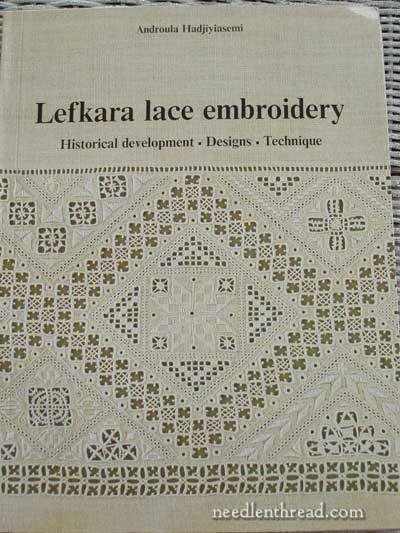
Lefkara Lace Embroidery is a hefty book in a number of ways. It weighs a lot for a paper back, for one thing. It’s packed with information on the history of Lefkara lace, the various designs used in the technique, instructions for working Lefkara lace, and, throughout the book, there are photos galore. The instructions take the reader through each stage of work, from preparing the cloth, cutting the threads, binding the edges of the cut areas, adding central fillings, working a variety of fillings, working the embroidered parts of the linen, working the hemstitched edges, and working the decorative edges of the finished piece. One point that comes clearly across through all the instruction is that there is order and method in working Lefkara lace, but at the same time, there’s a vast amount of creative freedom in choosing design and embellishment, because there are so many combinations of fillings and stitched elements possible.
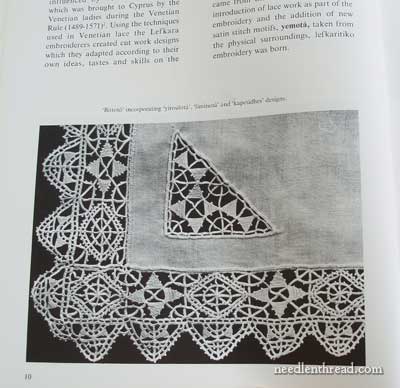
The book begins with a history of Lefkara lace and traces the development of it to the Venetian needle laces. You can see here an adaptation of Venetian needle lace in what the the Cyprians called “Bittotó.” The ladies of Lefkara eventually added certain motifs to the whitework styles that came from Venice, especially the satin stitched motifs typical in Lefkara lace, which they took from the art and surroundings of Cyprus. The author thoroughly covers the development of Lefkara lace, and it’s very interesting to read!
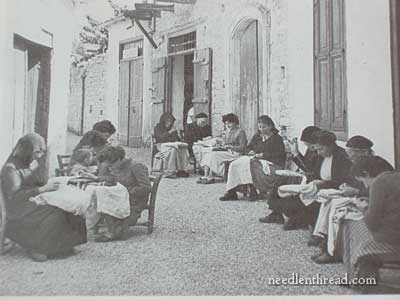
She supports the history with magnificent photos of the lace-making industry, along with up-close photos of old styles of Lefkara lace.
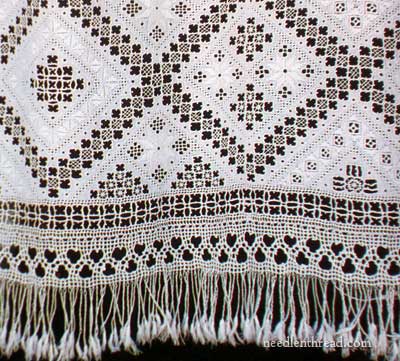
The older styles of Lefkara lace sometimes include elaborate edgings tipped with fringe.
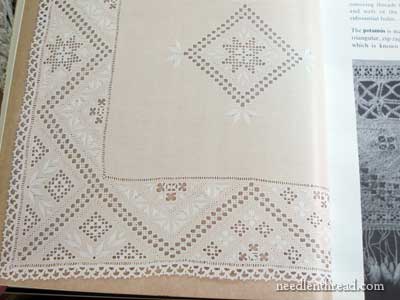
As the styles developed, though, the edgings became less elaborate, and the scalloped edge in the photo above is more typical of Lefkara lace over the last century.
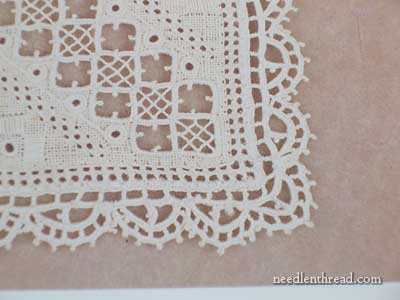
This is a more complex Lefkara edging which is not seen too often anymore, according to the author. The funny thing is, if I were to teach myself to work any of the techniques involved in Lefkara lace, this would be the one I would concentrate on. I love this edging! Incidentally, the ladies who worked this lace when the hand-made lace industry was strong didn’t necessarily work every element of the lace on a given piece. One person might cut the threads and do the initial binding or edging on the cut areas; another might work the surface embroidery; another, the elaborate fillings; another, the edging. This approach is typical to the cottage lace-making industries – it is the same way that Alençon lace in France used to be made, for example.
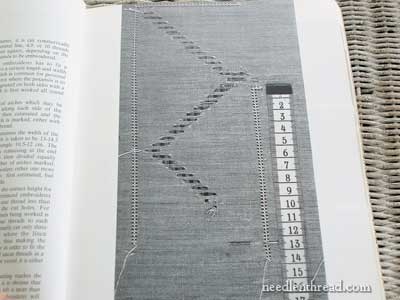
The author then proceeds step-by-step through the making of a piece of Lefkara lace. Here, you see a major difference between Lefkara lace and Hardanger. The threads in the linen for Lefkara lace are cut before any stitching is done. Also, the linen is much finer – from 40 to 50 count.
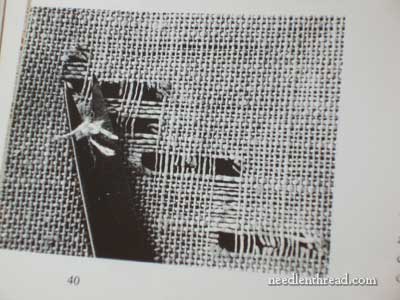
The technique part of the book is full of these close up photos of the various steps involved in making Lefkara lace. In this way, I think the book, published in 1987, is before its time. These thorough close-up photos of step-by-step processes in needlework didn’t become typical of needlework books until the mid-90’s, really. Occasionally, you’d find books with clear step-by-steps, but not too often. Showing the exact step-by-step process using photos of real work in progress was just coming into vogue. I love the picture above, by the way, because it answers a question I would ask, if I were trying to learn this technique from a book: how close do you cut your threads to the open areas? And you can see that they’re trimmed really close to the open area.
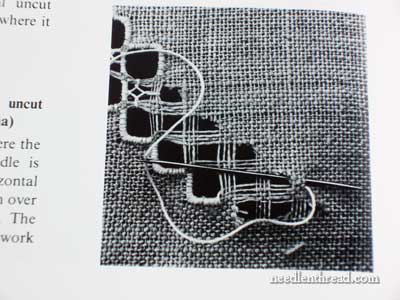
Another example of the step-by-step progress photo – working the edging around the cutwork area. You’ve probably noticed by now that the photos are black and white. There are a few colored photos in the book, but not many. They’re good black and white photos – very clear, with strong contrast. So it’s easy to see what’s going on in the photo!
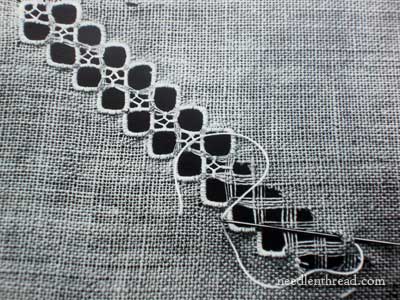
Each stage of progress is shown clearly, and the photos are accompanied by explanatory text.
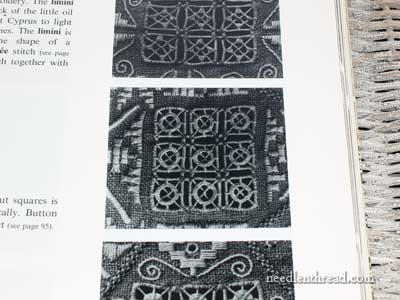
When it comes to the various fillings and the embroidered motifs, there are photos of heaps of examples of fillings. Beautiful fillings! And so many possibilities! Each photo is accompanied by explanatory text.
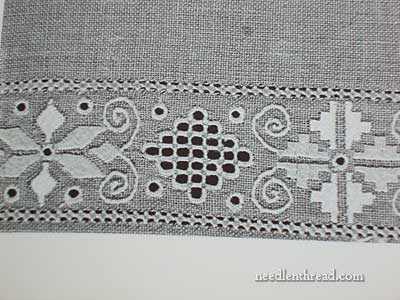
Not all the pieces in the book are super-complex. This is a nice, simple example of Lefkara lace.
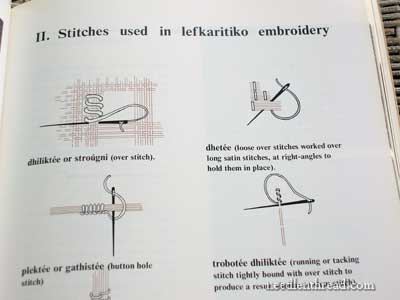
Towards the end of the book, there’s a stitch dictionary, illustrating in diagram form the various stitches used in Lefkara lace embroidery. Each stitch (and each technique throughout the book – and all the materials, too, come to think of it!) are given in their Greek names with their English translation.
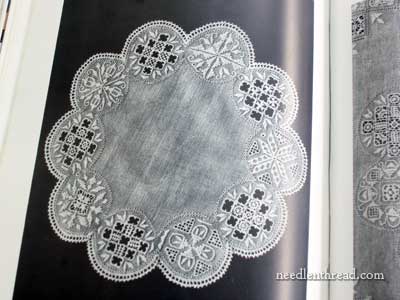
Ah – another “simple” piece of Lefkara, and one that demonstrates another difference between Lefkara lace and Hardanger: the use of curved lines. There are several examples in the book showing pieces that have flowing curved lines, scallops, and so forth. So while Hardanger is always done on the square, Lefkara has the possibility of curves and scallops and round edges.
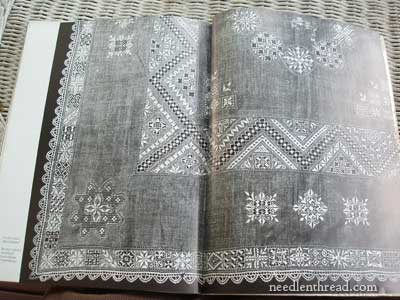
And wow! The pieces photographed throughout the book are surely a testimony to the beauty of Lefkara lace. Gorgeous, gorgeous, gorgeous!
Overall, the book is an excellent instructional book, and a fascinating history book. If you are interested in Lefkara lace and can find a copy of it at a price affordable for you, it is the only definitive book on the subject right now and is worth getting. It would be great to see it republished, but whether or not that will happen is a whole ‘nuther question! So keep an eye out for it – you never know where a copy might turn up!


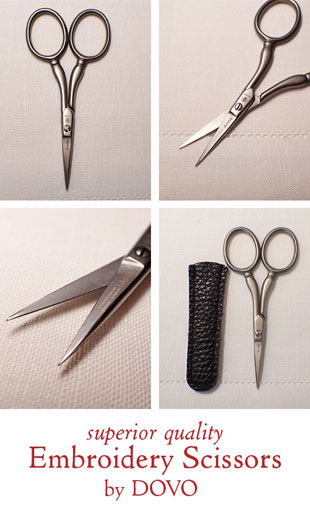



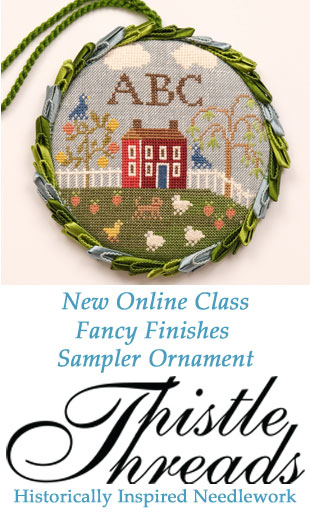
Dear Mary,
Thank you for your thorough review of the book. The price is quite unaffordable for me, but from your description it seems to be worth every penny. At any rate it looks like a feast for the eyes.
Many books on various subjects today are over $50, yet the binding just falls apart, or the subject is not covered thoroughly, or the illustrations are useless, or the pages turn yellow in a couple of years, and so on!
Again thank you. If you work on this type of embroidery in the future, perhaps we will learn at least some of the stitches from you.
Enjoy your weekend.
DorisHH
Hi Marymentor:
Happy June ! I’m sitting here spellbound with my mouth hanging open as I scrolled down through today’s blog ! Incredible ! My own needlework began at my Grandmother’s knee and she was from Poland as were all my ancestors. But the Eastern European influence always overlapped from country to country and this so much looks like some of my Babushka’s work ! Thanks again for the trip down memory lane !…….Judy in Pittsburgh
Hi Mary, Thank you for the education on Lefkara. I would not know about or maybe not appreciate all these types of embroidery if it were not for you website. Thank you for the time you spend to educate sitchers like me.
It always amazes me how the old needleworks are so full of such incredible detail. The working conditions back then weren’t great – imagine doing such intricate stitching by candlelight.
Barbara Fay, in Germany, has new copies of this book for €37 plus a flat rate of €5 for airmail postage anywhere outside Europe. She accepts various credit cards. (See under ‘Terms & Conditions’ on her website. I’ve been a customer of hers for years and never had any problems.
http://tinyurl.com/3pxtrz8
Thanks so much for the resource, Margot! I will add that link to the original article, so that folks can find it – thank you so much! ~MC
Perhaps we should all petition Dover Publishing to reprint this. They have kept a number of other lacework and embroidery books from falling into oblivion.
Mary–Thanks for posting about this book–WOW!
A quick check of http://www.worldcat.org shows two entries with only 2 libraries in the US: Hellenic Museum & Cultural Center (Chicago) & Harvard. Whether either would lend it remains to be seen but the OCLC # applicable to inter-libary loan is 45352918. And of course anyone lucky enough to live nearby or have travel plans, could always pop in to take a look. Please note that the book has not been reviewed on worldcat. May I suggest that you post your review there as it is a good resource that will be even better if you add your comments. Thanks also for pointing out the similarities/differences between Lefkara & Hardanger. While I admire Hardanger, all those little kloster blocks drive me nuts–just too many squares! The curves make Lefkara seem more flowing & graceful & the scalloped edge is a winner.
I reviewed your previous posts on Lefkara and watched the video. The pillows the ladies were stitching on facinated me. Would love to know other stitching styles, besides lace, that use lap pillows. I think there is a painting (Dutch perhaps) of a woman using a lap pillow as an embroidery aid.
Hi, Laura – that’s a good question. I like the pillows, too…. though I have to say, I’d probably opt for a hoop, even though it isn’t the traditional Lefkara way. I use a hoop for Schwalm work, which involves some of the same approaches to working the open-work filling techniques, and it works out well. I think the pillow, though, is ideal for working especially the edgings. I haven’t seen any other needlework technique that involves this kind of pillow, with the exception of bobbin lace. The various needle laces from Italy can be worked over a cloth or over paper (or even on paper, for a single motif of needle lace) but I’ve not seen pillows used. But maybe it’s a normal thing for people to use when working this kind of cutwork / needle lace, and I’ve just missed it somewhere along the way! Hopefully, someone else who has more experience with the Italian needle laces and Lefkara lace could help clarify that one!
~MC
Thanks Mary, for this fabulous review. It is a lovely form of needlework.
It’s a different pillow, but needlelace can be worked on a small bolster pillow. See: http://lace.lacefairy.com/Lace/PillowsBobbins/NeedlelacePillow.html
Superb review! I appreciate the work you’ve put into summarizing the text and providing photos from the book. I will definitely be following your blog.
Dear Mary
Thank you for reviewing this book.
I recently purchased a set of these books from Barbara Fey as a present for my embroidery group. We have 2 books extra and they are brand new and will be sold on E bay .If you or anyone you know would be interested in purchasing this book please pass on the word
Hi; I have this book in my needlework library. It seems to me that I bought it from an Italian Book site and paid 39 Euros for it. This was about 5 years ago–I have used it for two embroideries. Rena.
Do you have the books
1. Bibilla Knotted Lace Flowers (Milner Craft Series) Paperback – February 4, 2014
by Elena Dickson (Author)
2. Needle Lace Flowers: Creating Exquisite Flowers and Borders with Just a Needle and Thread- by Figen Cakir (October 1, 2013)
I am interested in NEEDLELACE.
WOULD YOU BE KIND ENOUGH TO RECOMMEND ONE…
No, I’m pretty sure I don’t.
I fear asking this question in case I cause another price increase. But the book is now $292 used – and $494 new.
That is ridiculous !! Any other – more affordable suggestions ?
BTW, awesome blog post !
Wow, that is expensive. You might have better luck through ABE books, maybe by searching in Italy or Greece or Europe in general. You’ll end up paying higher shipping, but you might find the book for a lot less.
Lefkara Lace Embroidery is still available from Barbara Fay in Germany for 45 Euros. Postfree within Europe, 5 Euros flat fee to overseas destinations.
Best wishes!
Rolf D. Fay
I would like to see placements and be able to choose from the image related
I cannot do that with this site the way it is presented .
I already have , bought a long time ago abroad, such Cypriot placements and am trying to acquire more pieces
What do you suggest that I should do ?
How can I proceed to have a specific choice of placemats and their napkins ?
Thank you for your answer ,
Regards,
Danielle Economou
La traduction devrait être automatique.merci
So happy to see someone else pointing out that Hardanger is not a catch all term for drawn thread and needlelace, but a particular style of drawn thread work. Its one of my bug bears, along with the mislabelling of the various different lace types. I’ve seen all manner of amelia ars, punto in aria, reticello, leftkara, hedebo, ruskin and more labelled as Hardanger! Its insulting to label it as such as each has its distinct culture and heritage that is reflected in the work. When its mislabelled, it is dismissive of the work’s true cultural history and heritage. This history needs to be preserved, not mangled into something it isn’t. Im not saying there isnt a place for modern cross over works, as there are some beautiful pieces of modern blended techniques out there. It just needs to be labelled as such, before we lose the rich heritage that has been handed down through the generations for safe keeping.
Keep up the good work as it is blogs like this that will help to pass on the true knowledge and understanding of the “gentle arts”.
I found the English-language version of this book for a “reasonable” price at a couple of book sellers in Cyprus (the only place it seems to be available anymore):
https://www.moufflon.com.cy/product/lefkara-lace-embroidery-historical-development-designs-technique/
https://philippidescy.com/shop/books/%ce%b3%ce%b5%ce%bd%ce%b9%ce%ba%ce%bf%cf%85-%ce%b5%ce%bd%ce%b4%ce%b9%ce%b1%cf%86%ce%b5%cf%81%ce%bf%ce%bd%cf%84%ce%bf%cf%82/embroidery/lefkara-lace-embroidery/
The price for the book isn’t too bad, but the additional cost of shipping to the U.S. is slightly more than half the price of the book. They also carry the Greek-language version, if you prefer that.
Hello, I realize this is an older post, but wanted to let anyone who sees it know what I have a copy of this book for sale for a reasonable price – $40. https://www.etsy.com/listing/1416357285/lefkara-lace-embroidery-historical